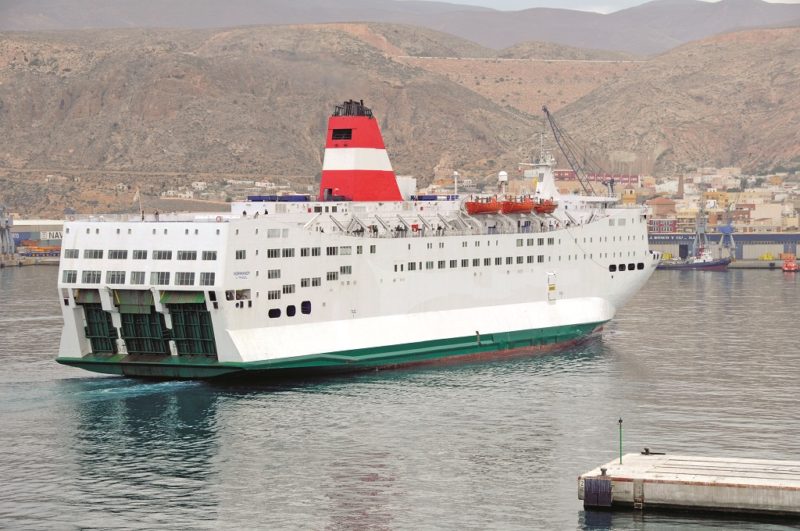
The Port of Almeria is very well known to me from many holidays in Andalusia and Murcia Provinces. When driving east from Malaga, one takes the exit 438 off the main E-15 motorway and then crosses back underneath the motorway to take a wide curve around a massive, jumbled scenery of white, grey, orange and red rocks before a very steep downward bank to the port road running along the beautiful Gulf of Almeria. This port road passes many berths for cruise ships and ferries loading passengers and freight for Moroccan and Algerian ports, and then passes the high loading staithes of the formerly big trade of exporting iron ore. The Marquesado Jetty at the Port of Almeria was opened on 27th April 1904 by Alphonso XIII, the King of Spain.
The port exported iron ore from 1904 to 1996, when mining finished, and the main trade of the port then became the huge new trade of ferry and cruise passengers and freight ro-ro cargoes.
Cap de Gata lies twenty miles east south east of Almeria on a high headland topped by a white lighthouse of 18 metres in height, and built to warn ships to steer clear of the notorious Laja de Cabo reef, scene of many shipwrecks and loss of life. There is a pretty beach and crystal clear waters popular with divers. The Cap de Gata National Park has 63 kilometres of coastline and is situated between Almeria, Carboneras and Nijar. The Tabernas desert of long stretches of yellow sand lies to the north of Almeria, and is where the many film crews gathered to shoot the great ‘Spaghetti Westerns’ starring and directed by Clint Eastwood, and the film ‘Lawrence of Arabia’ (1962) starring Peter O’Toole and directed by David Lean, and ‘The Wind and the Lion’ (1975) starring John Milius. Some of the town wooden sets, scenes of deadly gun duels, remain as tourist attractions in the dry desert. The desert has less than 6 inches of rain per year, with temperatures of this hot desert often above 31ºC.
On 28th May 2000, Javier Garcia-Guinea and a team of geologists found a spectacular cache of clear, transparent crystals made of hydrous calcium sulphate in a cave in an abandoned silver mine four kilometres from Almeria near the coast. The cavity measures 26.2 feet by 5.9 feet by 5.6 feet and is the largest geode cache of crystals of length 20 centimetres ever found. The cave was formed during the Messinian salinity period six million years ago when the Mediterranean evaporated and left thick layers of sediment. Ten people can enter the cave at any one time, with the possibility of turning it into a tourist attraction with a window to view from outside. Robbers are the main threat with the site under police protection and covered by five tonnes of rocks. This giant crystal cave is another of the many interesting facets of the geology of the area, that includes huge deposits of iron ore, as well as copper and silver, and with the scale and colour of the different rocks from different geological periods being very impressive.
THE IRON ORE PORT OF ALMERIA
The Marquesado Iron Ore Mine lies one hundred kilometres (60 miles) from Almeria towards Granada, in the Marqesado de Zenete region at location 37º10′ North, 3º07′ west on the eastern slopes of the Sierra Nevada.
The railway line from the mines crossed the Guadix plains, down the Nacimiento valley and through the Tabernas desert to reach the Great South of Spain Railway (GSSR), which ran all around the mining areas and was completed between 1890 to 1894.
There was only one passenger train per day and there were branch lines from Lorca to Baza and from Almendricos to Aguilas. Another branch line off the GSSR led eight miles to the Port of Almeria. Manual working was used in the mid 19th century, and mechanised production from 1904.
The manual method used up to 350 men working to unload the ore wagons by hand and dump the ore to ground at the station in heaps.
The ore was then filled into small baskets, which were carried two at a time by mules, and then carried onboard by manual labour to be thrown into the hold of the vessel.
Some one thousand tonnes of ore was loaded in ten hours as manual labour was plentiful at this time. Alternatively, the ore was tipped into barges which were towed out of the harbour to the tramp ships waiting offshore and were loaded onboard by the steam derricks of the vessel. The cargo was destined for the blast furnaces of Bilbao, Teesside or Rotterdam.
The Marqesado Jetty began to be designed with its many loading chutes from the summer of 1901 and was ready for use in April 1904, thereby saving a substantial cost of loading a vessel. This rate of loading vessels was further increased in the late 1920s with an initial mine production envisaged at between 100,000 tonnes and 200,000 tonnes per year and progressing eventually to a final production of half a million tonnes per year. ‘Marquesado’ or ‘Marquesate’ are the Spanish words for ‘belonging to the Marquis’, such as the inheritance received by a son of a Marquis from his father on his death.
The Compania l’Andaluza de Minas (CAM) produced 33,898 tonnes of iron ore in 1930, 34,661 tonnes in 1931, 52,241 tonnes in 1932, 39,685 tonnes in 1933, 39,212 tonnes in 1934, and 87,994 tonnes in 1935. The slaughter of the Spanish Civil War fought in bloody battles in an anti-clockwise direction around Spain between 1936 to 1939 saw the mine temporarily closed. The iron ore was transported away in the big dry cargo tramp fleet of Sota y Aznar of Bilbao, some of which were motorships with bunker fuel supplied to the port by Campsa (Compania Arrendataria del Monopolio de PetroleosSA).

These fleets included the following steam and motor powered vessels with their deadweight tonnage:-
SOTA Y AZNAR CAMPSA
Arinda-Mendi 6,035 Badalona 4,185
Aritz-Mendi 8,650 Campas 6,276
Arnabal-Mendi 3,907 Campeche 6,382
Arnotegi-Mendi 5,531 Campero 6,382
Arola-Mendi 9,250 Campalans 1,554
Artagan-Mendi 5,717 Camprodon 1,024
Artea-Mendi 5,680 Campilo 4,525
Artiba-Mendi 3,560 Campoamor 7,873
Artxanda-Mendi 4,936 Campuzano 6,320
Artza-Mendi 6,366 Campamento 10,797
Atxuri-Mendi 1,597 Campanario 8,636
Axpe-Mendi 3,868 Campana 8,636
Aya-Mendi 3,875 Campante 10,592
Bizkargi-Mendi 4,810 Campanil 10,600
Eretza-Mendi 6,650 Campeon 10,551
Igotz-Mendi 7,346 Campas 10,650
Jata-Mendi 7,195 Campiz 10,588
Ordunte-Mendi 6,102 Campoblanco 9,260
Upo-Mendi 6,515 Campomanes 8,397
Urkiola-Mendi 5,088 Camponegro 9,250
Urko-Mendi 5,768 Campoverde 9,250
Unbe-Mendi 6,800 Campeon 22,353

Sagunto was the other great iron ore exporting port of the Spanish Mediterranean coast near Valencia with its integrated steelworks. Gorbea-Mendi of 2,911 grt had been built by William Gray at West Hartlepool as Balderton in 1896 for the Dale Steamship Co. Ltd., but ran aground on Le Plateau Cromic near Brest on 13th October 1911 while on a voyage from Sagunto to Rotterdam with iron ore.
She was refloated and sold and repaired in dry-dock at Brest and renamed Pomone by French owners, but was torpedoed and sunk by UC-79 on 24th November 1917 seven miles off Tazones at Santander while on a voyage from Lisbon to Brest with phosphates and wine, one crew member lost his life.
The Marquesado iron ore was composed of haematite and limonite, with the host rock of the area being limestone from the Upper Triassic period some 220 million years ago. The Marquesado mine in post-war years was re-equipped with extensive, modern mining equipment and reached production levels of over 100,000 tons in the 1950s, 108,000 tons in 1962 and 159,000 tons in 1963.
The French iron ore and nickel mining company IMETAL of St. Laurent de Brevedent in Normandy gained a 61% holding in 1974, and again vastly increased iron ore production to reach 3.379 million tonnes in 1982, 3.270 million tonnes in 1983, 3.728 million tonnes in 1984, 3.311 million tonnes in 1985, and 3.557 million tonnes in 1986. In 1989, the rail line from the Marquesado Mine to the port was re-electrified with 3,300 volt electricity and new locomotives of increased horse power.
They were of Japanese design and very powerful and had great traction capability, and were able to be double headed to haul over 2,000 tonnes of iron ore for one hundred miles. Thereafter, cheaper Western Australia and Brazilian took the market away from this the biggest iron ore mine in Southern Europe. Shipments of iron ore from Almeria finished in 1996, with IMETAL having sold off CAM in 1988.

A second iron ore loading jetty just upstream of the Marquesado Jetty is the Alquife Jetty, also known as the Cable des Ingles (English Pier), and loaded iron ore from the Alquife Mines and Railway Company from mines near Granada. It was designed and built in 1904 by Scottish engineers, but was taken out of use in 1973. It is lit up at night showing all of its loading chutes are intact, and recently a new wooden approach promenade has been built over a bridge to the pier. Loading rate was around 800 tonnes per hour.
A third iron ore loading jetty was located half a mile from the other two jetties outside the harbour on the San Miguel beach. It was known as the Cable de Frances (French Pier) and was built in the early 1920s. The ore again came from the Alquife Mines, with the jetty built of concrete with an initial length 228 metres from 1918, with an additional concrete section of 85 metres added in 1975. The width of the jetty was between nine and twelve metres, and the rail line transported double headed locomotives pulling 2,000 tonnes of iron ore in the 1980s. The line went out of use in the 1990s, and there have been projects to pull it down to expand the local marina, or more likely to convert it so that the Paseo Maritimo walkway runs under it in the Port of Almeria projects. A ferry with 188 passengers onboard collided with the Cable de Frances on 31st July 2007 and did some damage.
Today, the Alguife mine is huge in area at 633 hectares and is the largest open pit iron ore mine in Europe producing 4.5 million tonnes of iron ore per year with proven reserves of 110 million tonnes.
Whereas in the Nasrid period of the tenth to twelfth centuries, Spanish labour extracted iron ore and to a lesser extent silver and copper, British, Dutch and Belgium companies operated the mines in Victorian times and built the railways up to the late 1880s. Ownership of this gigantic mine was soon taken over by Spanish companies, with a 61% share taken by a French company in 1964.
However, the mine closed in 1986, but the assets were purchased by Minas de Alquife S.L.U. in 2008, and now all of the necessary land permits and environmental requirements have been met with full production resumed on 1st September 2020 with most modern extraction techniques for this high quality iron ore. Electricity was needed from the start of the 20th century to work the mines, and this led to the residents of the Marquesado of Zenete region having electricity and light in their homes from over a century ago.
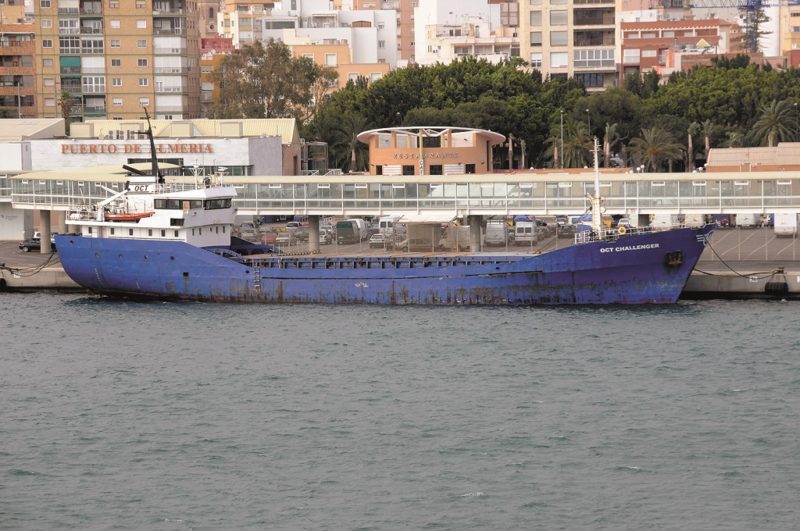
PORT of ALMERIA STATISTICS
The Port of Almeria Office (Oficinas de la Autoridad Portuaria) is on the Muelle de Levante with the Harbour Master (El Capitan de Puerto) at the end of the quay. The port had a total traffic figure of both imports and exports in 2019 of 5.639 million tonnes, with 950,000 passengers on ferries and cruise ships, and around 30,000 TEU of containers passing through or transhipped. This included all liquid bulk, dry bulk, general cargo, ro-ro, container traffic, cars and trucks, other cargo and fishing totals. The length, alongside draft, and width of all of the berths in the port in metres were as follows:-
Muelle Levante (East) 219.0 8.0 45.0
Ro-ro, general cargo, passengers
Muelle Ribera 1 281.0 10.0 70.0
Ro-ro, general cargo, passengers
Muelle Ribera 2 450.0 9.0 135.0
Ro-ro, general cargo, passengers
Ro-ro Dock 2 200.0 10.0 20.0
Ro-ro, general cargo, passengers
Ro-ro Dock 3 200.0 10.0 20.0
Ro-ro, general cargo, passengers
Ro-ro Dock 4 184.0 10.0 20.0
Ro-ro, general cargo, passengers
Ro-ro Dock 5 157.0 10.0 20.0
Ro-ro, general cargo, passengers
Muelle Ribera-Poniente 300.0 11.5 40.0
Ro-ro, general cargo, passengers
Muelle Poniente 1 (West) 359.0 10.0 90.0
General cargo, dry bulk, TEU
Muelle Poniente 2 (West) 258.3 12.0 90.0

Liquid Bulk
Muelle de Pechina 313.0 15.0 90.0
Dry bulk
Marquesado Jetty 313.0 15.0 90.0
Dry Bulk
Outer Dock 416.7 18.2 20.0
Inactive dock, lock open
COMMERCIAL DOCKS 3,651.0 metres length
FIVE MARINAS 501.0 metres length
SEVEN FISHING BERTHS 1,250.0 metres length
TOTAL PORT BERTHS 5,398.0 metres length
PORT STORAGE, WAREHOUSES and ROADS (in m2)
Quay Covered +Open Storage Warehouse Road Length
- East 10,601 2,025 13,769
- Ribera 1 37,608 12,106
- Ribera 2 16,537 10,814
- Ribera-Poniente 44,116 44,072 41,700
- West 14,713 17,494 47,224
- West Phase 1 74,750 9,205 47,430
- West Phase 2 37,189 15,477
- Fishing Port 3,435 61,985 78,636
- Marinas 4,169 7,630 63,502
TOTAL 188,973 196,556 330,658
Harbour Approach
The Port of Almeria lies at the foot of very high mountains on the wide Gulf of Almeria, with all arrivals and departures able to be made in good and moderate weather conditions, but winds from the east can whip up an uncomfortable swell for small yachts in the harbour before they reach the marinas. There is the very visible Muelle de Poniente forming the west breakwater to the port. The Dique Exterior Breakwater of length 417.7 metres off the Muelle de Pechina has depths of 15 to 25 metres on the deep-water side of the breakwater. The Harbour Mouth faces south east and is of width 300 metres with a depth of 13.0 metres, and very little slow flowing currents, while the Entrance Channel also faces south east and is of width 200 metres and length of 498 metres with a depth of 13.0 metres on a bottom of sand. The prevailing wind is south westerly and the maximum tidal range is only 2.0 feet.
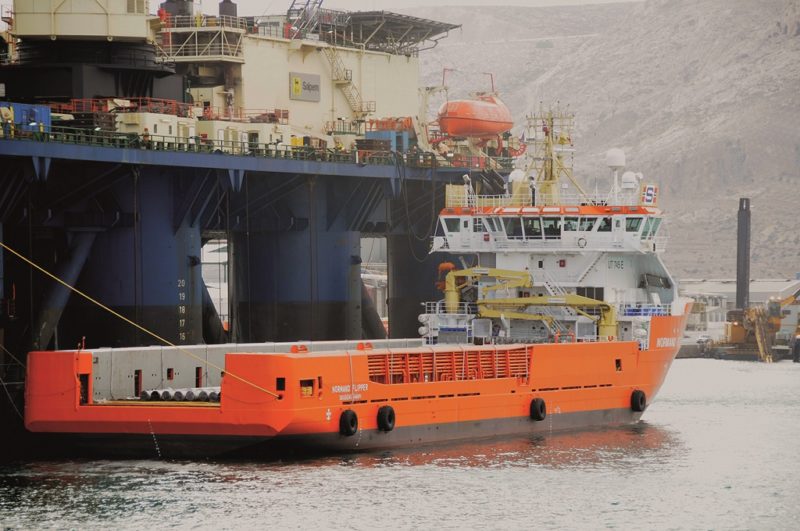
Approach and Harbour Lights
Cabo de Gata lighthouse on top of a rocky mountain to east
Punta del Sabinal lighthouse on a low lying flat headland 10 miles to south west
San Telmo Castle light to west of the harbour on top of a rocky promontory, with white oblong light and a black stripe on the castle
Puerto Pesquero Dique East Light with round masonry tower
Puerto Pesquero Dique South Light with round masonry tower
Dique de Poniente Light (West breakwater) with white eight sided tower
Dique de Levante Light (East) with green metal framework tower
Muelle de Practicos (Pilots) leading lights
Marquesado Jetty Light with black metal post
Power Station Light with cardinal topmark on yellow framework tower and black band
Fuel oil and diesel oil bunkers are supplied by Eutrasur S. L., the official distributor of CEPSA oil products, Jimenez Lopera S. A., the official distributor of REPSOL oil products, and ESK S.A. as the supplier of liquid natural gas (LNG). Supplies of fuel oil, diesel oil, biodiesel and biodiesel products doubled in 2020, and there were small increases in the dry bulk trades of petroleum coke, construction materials, foodstuffs, steel products, china clay, feldspar, cement and cement clinker, gypsum, fertilisers and slag. The general cargo ship Nordersand brought in a cargo of wind turbine towers, nacelles and blades.
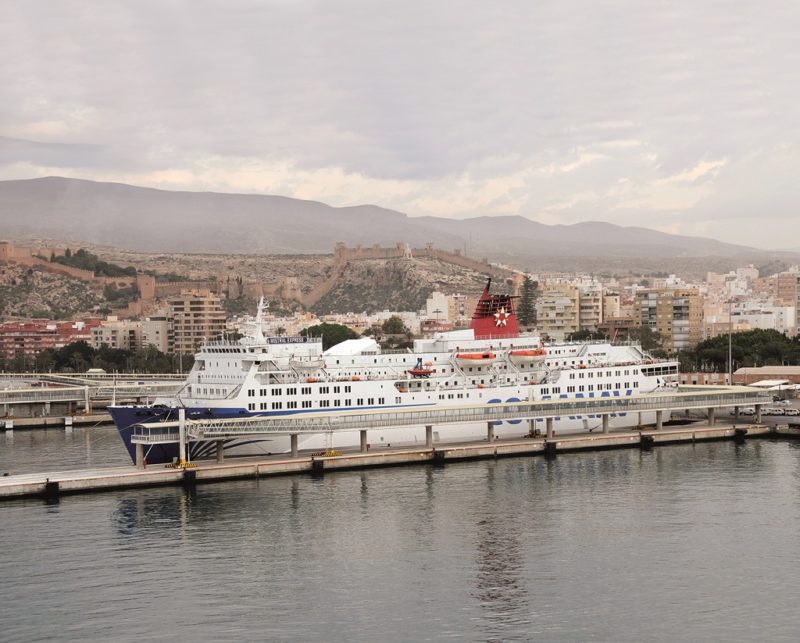
FERRY AND CRUISE TERMINALS
Access by vehicle to the Maritime Station (Ferry Terminal) is at the Pescaderia (Fishing) Roundabout where there are large signs for the African destination ports of Melilla, Nador, Al Hoceima, Ghazaouet and Oran. There are a total of seven ferry and cruise ship berths, with passengers entering the two – storey modern Terminal building with 8,400 square metres of space. The large public areas have ticket offices, information points, café, public toilets, waiting rooms, cash ATMs, wifi, information screens, and the reception points of the various ferry and cruise lines and travel agencies. The building also houses the Control Centre of the Port Police, Civil Guard and National Police, as well as an office of the Autoridad Portuaria de Almeria (Port Office). The building is connected on the top floor by horizontal moving walkways to allow fast embarkation and disembarkation of foot passengers, after Spanish immigration checks. The vehicle customs and inspection areas are situated next to this building. Ferry lines must supply four copies of their passenger and crew lists on arrivals and departures, as well as spirits and wine levels and dry stores. Health declarations must be made by all passengers and crew, as well as copious declared cargo documents.
The ferry terminal for North African passengers is always busy 24 hours a day. Moroccan and Algerian nationals living in Western Europe use the crossings from Almeria to visit relatives in the summer. The port offers several sailings per day to five different destinations in Morocco and Algeria. Some of the car waiting areas are covered to protect passengers waiting under the hot Mediterranean sun, some having travelled large distances to the port. All foot passengers are protected from the sun in the waiting areas of the terminal. The loading and unloading of cars do not interfere with the embarkation and disembarkation of foot passengers. There are restaurants and supermarkets on the main road along the Gulf of Almeria outside the port area.
At the sea entrance to the port is a very large tower for the personnel operating the Vessel Traffic Services (VTS), this is vitally needed as several ferries can reverse and dock at the same time. The Port of Almeria uses Mediterranean stern mooring, whereas the North African ports use bow mooring. The ferry lines using the port are Acciona Trasmediterranea, SNCM and Balearia for Algeria and Morocco. The four cargo ro-ro berths are on the Muelle Poniente (West) opposite side of the Darsena Commercial (Commercial Harbour) to the passenger berths for Oran (Algeria), Melilla (Spain), Nador (Morocco) and Al Hoceima (Morocco). The latter port lies at the tip of a peninsula on the north edge of the Rif mountains, and was developed from 1925 and became part of an independent Morocco in 1956. The ticket prices for all of these longer routes across the Mediterranean are more expensive than the main Tarifa to Tangiers route, but are much more convenient for people travelling to the Rif area of Morocco or to Algeria.
There are supplies of gas and oil at the Fishing Port, and water and electricity at all of the commercial docks at 230/400 volts. In the Darsena Commercial (Commercial Harbour) a service road with a width of eight metres runs around the back of the Muelle Poniente (West Docks), and at the start of this road is the access to the Fishing Dock with a main road of width 10.5 metres. The service road extends to the eastern part of the Ribera Docks, continuing along these docks to the warehouses. On the left bank of the Rambla de Belen, there is a service road that links the Darsena Commercial with the Marquesado Jetty of the former Compania l’Andaluza de Minas S.A. (CAM). There are good rail links to all other Spanish main cities on the RENFE lines, and there is a good road to Almeria Airport which is only eight kilometres away. Coaches run from Almeria Intermodal Station with departures for Barcelona, Madrid, Seville, Cordoba, Cadiz, Grenada, Jaen, Malaga and towns in Murcia Province. The population of the City of Almeria was 168,000 in 1998, and 189,000 in 2007, and 201,322 at the last census in 2020.
THE FERRY AND CRUISE LINES of the PORT of ALMERIA
FerriMaroc
FerriMaroc was the trading name of Cenargo Espana, a Spanish private sector company owned by Cenargo of Britain. They was founded in 1986, and the first ferry I saw in Almeria being the well-travelled Scirocco in 1995, which continued in service at Almeria until 2004 wearing a white FerriMaroc funnel with a green top and a thin zig-zag red line between the two colours. She had been built in 1975 as St. Edmund of 11,177 grt by the Cammell Laird yard at Birkenhead at a cost of £7.5 million for the Sealink Harwich to Hook of Holland service, starting her career on 19th January 1975. She was requisitioned by the British Government for Falklands War service on 12th May 1982 to transport the 5th Infantry Brigade to Port Stanley. She then operated a regular trooping service between Ascension Island and the Falklands until she arrived in the Tyne on 28th January 1983 for shiprepair work to be carried out. She was then compulsorily purchased by the Government for the Ministry of Defence, and renamed Keren to operate in the Falklands until July 1985 as a floating landing stage for one thousand troops at Port Stanley.
She was sold in January 1986 and renamed Scirocco by the Cenargo Group, who operated the FerriMaroc service between Almeria and Nador. She had a passenger capacity of 950 with space for 296 cars and 26 lorries on her car deck. She was also during the next 18 years used on short charters to Tirrenia di Navigazione of Italy, Trasmediterranea of Spain, Comanav to Morocco, Cotunav to Tunisia, and to British Channel Islands Ferries for Poole to Guernsey and Jersey service as Rozel between 1989 and 1992. She was sold in April 2004 to El Salam Maritime of Egypt and renamed Santa Catherine 1, and later was renamed Sara 1 on 30th May 2006 for the pilgrim route between Jeddah and Suakin (Sudan). She was sold to Indian shipbreakers in July 2009 after a 34 year career.
FerriMaroc also operated Mistral of 20,220 grt as Mistral Express, and built by the Dubigeon Normandie yard at Nantes as Esterel for the SNCM service between Marseille and Corsica and services to North Africa. She was sold to Cenargo in 1997 and renamed Mistral Express for the FerriMaroc service between Almeria and Nador, taking six hours each way with up to 2,282 passengers and 680 cars and 40 lorries.
The ferry Wisteria of 13,505 grt, built in 1978 by the Verolme Heusden yard in Holland as Prinses Beatrix for SMZ of Holland, also served FerriMaroc between 2006 and 2012, with accommodation for 1,500 passengers, 350 cars and a lane length on her car deck of 528 metres. She had a service speed of 21 knots from four Stork Werkspoor diesel engines, and was later broken up in 2021 in Turkey. FerriMaroc was taken over by Trasmediterranea of Spain in 2010, although FerriMaroc tickets were still on sale for some years. The passenger ferry Normandy built in 1981 operated on charter in the summer of 2008, Sherbatskiy built in 1980 operated on charter in the summer of 2012, and also Isabella 1 built in 1981 on charter in the summer of 2013.
Acciona Trasmediterranea
‘La Tras’ is the colloquial name that Spanish people use for their much loved national ferry line. New Years Day of 2017 was the centenary anniversary of the first day that their Spanish national ferry line began to run services to its many destinations including the Balearics, Ceuta and Melilla in North Africa, the Canaries, and the Spanish colonies of Fernando Po and Spanish Guinea in West Africa. Nine small companies came together on that day one hundred years ago, namely Maritima Barcelona, Gijonesa, La Islena Maritima, Menorquina, Navegaceon y Industria, Tintore (founded by Pablo M. Tintore in Barcelona in 1852), Valenciana and Vinuesa fleets. The actual instrument and deed of the constitution of Compania Trasmediterranea was signed in Barcelona before the Public Notary Antonio Sasot Mejias on 25th November 1916 by Joaquin Maria Tintore of Linea de Vapores Tintore, Enrique Garcia Corrons of Navegaceon y Industria S.A., Jose Juan Domine of Compania Valenciana de Vapores Correos de Africa, and Vicente Ferrer Pesset on behalf of Ferrer Pesset Hermanos companies.
Trasmediterranea operated an important passenger service between Malaga and Melilla, a Spanish enclave in North Africa, in post-World War II years. A service between Almeria and Melilla was begun in 1970, and used both Ciudad de Badajoz built in 1979 and Ciudad de Salamanca built in 1982 on this route. It currently operates the passenger ferry Ciudad de Ibiza on this service together with the fast passenger craft Almudaina Dos. The larger passenger ferry Juan J. Sister operates between Almeria and Nador, and the passenger ferry Las Palmas de Gran Canaria between Almeria and Ghazahouet.
The passenger ferry Almariya was also operating until recently on the Almeria to Melilla route but received very bad press reports regarding the amount of rust on the ship and the state of her toilets. She was built forty years ago as the first newbuild Olau Line ferry Olau Hollandia in 1981 by the A. G. Weser yard at Bremerhaven. She also suffered a bad fire on 7th September 2017 due to an electrical fault after leaving Nador for Almeria, and became disabled for 18 hours, leaving 1,668 passengers stranded while she was towed back to Nador by two tugs. The much-delayed crossing was completed by fast craft Alborin and the chartered Armas fast ferry Volcan de Teno. During her long career, she has also had numerous incidents including damage to her propellers, and collisions to quays with holes in her hull above the waterline.

Balearia
Balearia is the trading name of Eurolinies Maritimes, a Spanish private sector ferry company. It connects the Spanish mainland to the Balearic islands of Mallorca, Menorca, Ibiza and Formentera, as well as providing inter-island crossings, and regular services in the Straits of Gibraltar. Balearia operates both fast craft and conventional passenger ferries, transporting 3.5 million passengers annually. The company was founded in Alicante in 1998, with eight ferries operating in 2003, and now has a large fleet of 25 ferries, with new routes established in the Caribbean and Gulf of Mexico under the name of Balearia Caribbean.
The crossings between Algeciras, Tangier Med and Ceuta across the Straits of Gibraltar are operated under the name of Balearia Nautas. The current service between Almeria and Nador is operated by the passenger ferry Wasa Express of 17,053 grt and built in 1981 by Wartsila of Finland as Travemunde for the Gedser to Travemunde link with accommodation for 1,850 passengers, and space for 550 cars and lorries on 1,150 metres of lane length. She also operated for Fred. Olsen Lines as Betancuria during 2011/12. The distinctive hull colours of Balearia are white for the forward part of the hull, and green for the stern section.
Comanav and Comarit
Comanav (Compagnie Marocaine de Navigation) and founded in 1946, and Comarit (Compagnie Maritime Morocco-Norvegienne), a private sector Moroccan company owned by Fred. Olsen Lines were in business for fifty years on passenger and freight routes to North Africa. In 2007, the State of Morocco privatised Comanav, which was leased to a consortium represented by CMA-CGM of France for 2.2 billion Moroccan dirhams equivalent to €200 million.
The French company sold the passenger business to Balearia but continued to run freight ro-ros, with Balearia selling its share to Comarit for €80 million in February 2009. Comarit was later bankrupted with the fleet of ferries beginning with the letter ‘B’ sold off (‘B’ names were taken from Fred. Olsen), and both Comanav and Comarit no longer operate ships.
Comanav had a fleet of nine ferries in 2003, and Comarit had a fleet of four ferries in the same year, with some operating on the Almeria to Nador link.
The former Townsend Thoresen ferry Free Enterprise V of 5,044 grt and built in 1970 with accommodation for 1,132 passengers, and space for 202 cars on a lane length of 400 metres, operated for Comanav between 2003 and 2005 as Tadla.
SNCM (Societe Nationale Maritime Corse Mediterranee)
SNCM Ferryterranee is the trading name of Societe Nationale Maritime Corse Mediteranee, a French public sector shipping company serving Corsica and Sardinia from Marseille, Nice and Toulon, and with also a passenger route between Almeria and Ghazahouet in Algeria. The company can trace its ancestry back to Compagnie General Transatlantique (CGT) of 1850, but this modern ferry company was formed out of Compagnie Generale Transmediterranee in 1976 with a new funnel livery and houseflag. SNCM operated a fleet of thirteen passenger ferries in 2003, the largest being Mediterranee of 30,985 grt with accommodation for 2,435 passengers and 804 cars and built in 1989 as Danielle Casanova, Napoleon Bonaparte of 44,307 grt built in 1996, and Danielle Casanova (2) of 44,400 grt built in 2002 with accommodation for 2,440 passengers, 700 cars and 60 freight units. In addition, the twin funnelled monohull fast ferry NGV Asco of 38 knots speed and built in 1996 carried 576 passengers, 148 cars and four freight vehicles on the Almeria to Ghazahouet route. The sister twin funnelled monohull fast craft NGV Alisco operated to Corsica from Southern French ports including Nice. NGV is short for Navire a Grand Vitesse.
Cruise Ships
There are two cruise ship berths in the Port of Almeria along the Muelle de Ribera and at the east end of the ferry berths. During the period from 2000 to 2020, an average of forty cruise ships arrived per year. A total of 25 cruise ships called at the port in 2019, with COVID-19 cancelling most other calls in 2020 and 2021. The calls in 2019 were:-
Windstar Cruises (12), Fred. Olsen Cruises (3), Oceania Cruises (3), Regent Seven Seas Cruises (3), Crystal Cruises (1), Azamara Cruises (1), P. & O. Cruises (1) and Marella Cruises (1).
A dozen cruise ships were due to arrive in the 2022 season.
These are Phoenix SeeReisen, Azamara Cruises, Star Clippers, Windstar Cruises, Regent Seven Seas Cruises, Oceania Cruises and Marella Cruises.
Container Ships, Freight Ro-Ros
Maersk Line have an office on the Muelle de Ribera for calls on their feeder container services to their freight hub at Algeciras harbour, with MSC having an office in Valencia harbour. The blue hulled Alana of length 149.0 metres by beam 22.0 metres is a typical feeder container ship using the port. Trasmediterranea have operated freight ro-ros from the port, including a trio of near sisters named Superfast Canarias, Superfast Andalucia and Superfast Levante and able to carry up to 192 trailers at a service speed of 22 knots.
Bulk carriers of up to Panamax size e.g. SBI Pisces bring in cargoes of grain and other dry bulks. Coasters owned by Wilson Line of Norway, Wagenborg of Holland, the green hulled Lehmann fleet of Hamburg, and the Baltic Shipping Company A/S of Denmark arrive or depart with bulk cargoes of up to 6,000 tonnes.
Tugs
The Port of Almeria Servicios Auxiliares de Puerto S. A. (SERTOSA) are in charge of harbour towage with two tugs of 2,500 bhp on dimensions of 29.0 metres by 8.0 metres by 5.0 metres named Sertosa XXIV built in 1985, and Sertosa XV built in 1974. Boluda Towage of Spain with a fleet of over 300 tugs may also be present at the Port of Almeria.
The tugs Boluda Fos built in 1992 with a bollard pull of 92 tonnes, VB Teckel of 272 grt and built in 1985, VB Andalucia of 5,440 bhp with a bollard pull of 55 tonnes, and VB Almeria of 237 grt built in 2007 but since sold are typical tugs of the fleet.
Senor Vicente Boluda Fos (born 31st March 1955) is President of the Boluda Group, President of the National Association of Shipowners, Vice-President of the Spanish Shipping Association, and in 2009 he was the 17th President of Real Madrid football club. The deep-sea tug A. H. Varazze, owned by Saipem of Italy and of 19,000 bhp and a bollard pull in excess of 220 tonnes, towed the semi-submersible oil rig Scarabeo 3 into Almeria from Lagos-Apapa in Nigeria in December 2015.
One of the large orange hulled tugs of the Salvamento Busqueda y Rescate (Search and Rescue) is permanently stationed in the Port of Almeria. The tug SAR Mastelero of 907 grt and built in 2011, the Emergency rescue ERRV Guardamar Polimnia of 179 grt and built in 2009, are supplemented in coastal waters with the launch Salvamar Denebola.
SUMMARY
The Port of Almeria is slowly recovering from the effects of reduced traffic due to COVID-19 restrictions, with a drop of 86.75% in 2020 in passenger numbers to 127,008 over the 2019 figure of 957,975. The month of July 2021 some 5,075 ferry passengers and 1,471 truck drivers passed through the port, a 36.5% increase over the same month in 2020.
The three-month period from 15th June 2021 to 15th September 2021 saw nine ferries running to or from the ports of Melilla, Nador, Oran and Ghazaouet and carried 582,378 passengers and 131,425 trucks and commercial vehicles, the latter figure was 7.0% higher than the same period of 2020.
On-going projects in the port include the supply of LNG to most berths, land connection from the Dique de Pechina to an outer breakwater which currently has no connection to the mainland in order for larger draft ships to dock at an extra 3.7 hectares of extra dock space, improvements in the handling of heavy vehicles, expansion of the width of the Muelle de Pechina, expansion of cruise facilities at the Levante Pier when cruise traffic finally resumes former levels, creation of a pedestrian promenade on the Cable del Ingles (English Pier), and to the nearby Yacht Club de Mar and the Paseo Maritime, and an upgrade of the Almadrabillas and other waterfronts.
As well as visiting the port, a visit must be made to the magnificent Alcazaba Monumental Complex of Almeria (Conjunto Monumental de la Alcazaba de Almeria). The walls of the Northern Front are currently being restored, and the historic complex is open for visits from 0900 to 1800 hours Tuesdays to Saturdays.
There are many yellow sandy beaches nearby, such as Sweet Water Beach (Playa de Aguadulce) to the west of the city, and in the Cabo de Gata area to the east of the city. Almeria is unique in that it has a great climate, and along with Seville and other lucky places in Southern Spain, the winter temperature has never reached down to zero degrees in its recorded weather history, a great advertisement for its winter tourism.

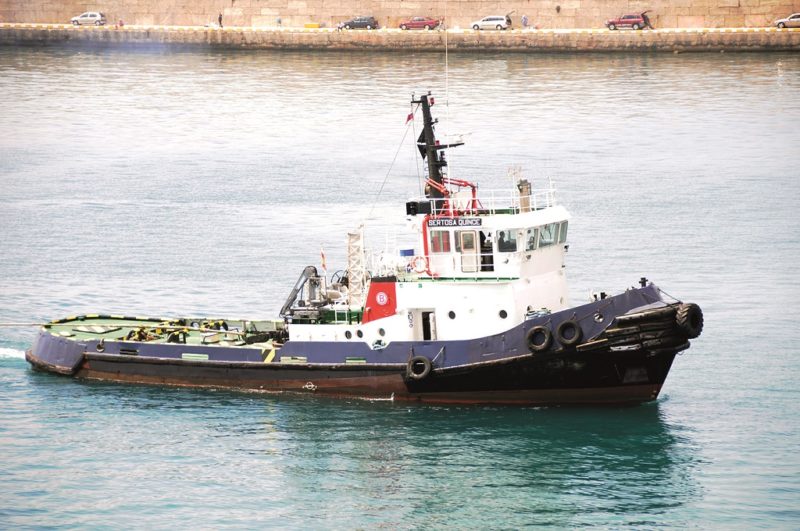
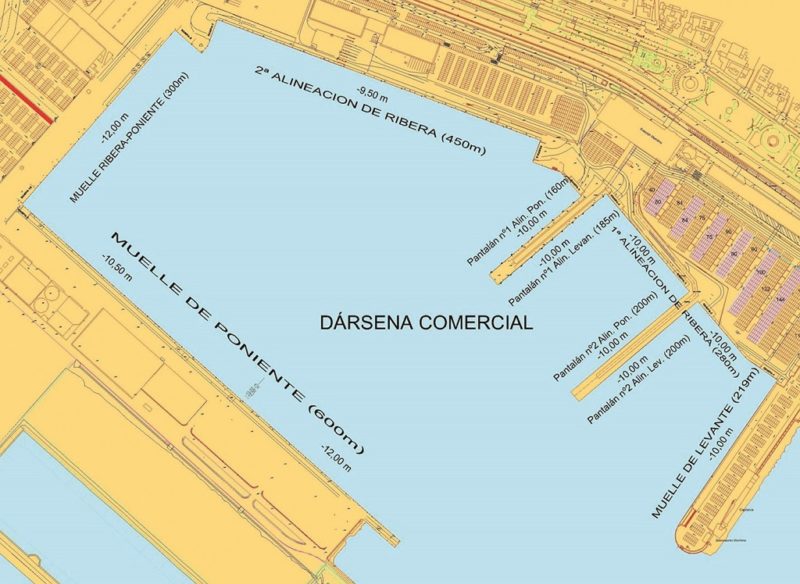
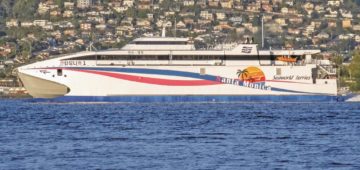



Comments
Sorry, comments are closed for this item